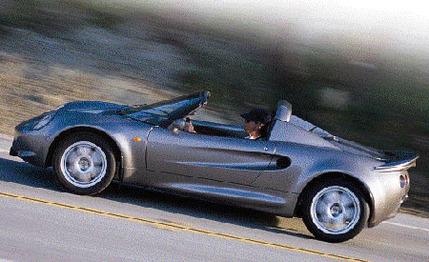 Specialty File
Specialty File
Lotus has not been able to import its diminutive Elise into the U.S. because of various compliance issues, one of which is the complete absence of airbags; another, the nonconforming Rover engine that powers the car. You can get one to race, but not to drive on the street. Still, there is one street-legal Elise you can buy here-from Sun International, a small import company that swaps the offending powertrain for one from an Acura Integra Type R. Yes, that Type R-the one that revolves at speeds that few small four-cylinder sedan engines have ever contemplated. And in this case, an unnamed Japanese tuner company modifies the engines further so that max power is wrung out at a heart-rending 8200 rpm.
In this new configuration, the rev limiter steps in at a heady 9100 rpm to preempt fragmentation, since the relatively long-stroke Acura engine boasts piston speeds up there in Formula 1 territory. On the test car Sun International lent us, the tachometer only extended to 8000 rpm, where the needle would stop in protest. But even at that modest speed, the close proximity of the engine (with its repackaged induction and exhaust plumbing) lent emphasis to the exertions of the 1.8-liter four, uttering a deafening cacophony and begging for good earplugs. Calculating just where the power peak should be after the tach needle stalls at 8000 rpm is an exercise in aural abuse. We just left it to rev a few seconds more, then snatched another gear.
Even with its engine mounted amidships, transferring some 62 percent of the car's 1719 pounds to the rear wheels, the engine's claimed 200 horsepower is more than enough to smoke the rear tires from rest. With elevated compression levels (11.3:1 instead of the stock motor's 10.6:1), a lightened flywheel, and lower VTEC shift points, the modified Type R motor propels the Elise quite a bit quicker than does the Rover engine in the original car. It thrusts the Elise to 60 mph in just 4.6 seconds (the 118-horsepower Rover engine needs 5.2 seconds) and trips the quarter-mile lights in 13.4 seconds at 104 mph. But it's not straight-line speed that is the Elise's most alluring aspect.
It's the roadgoing dynamics, the handling, and the organic sense of control its driver enjoys as this light car darts down the road. With just over 1700 pounds gently denting the asphalt, the Elise has unassisted steering and unboosted brakes. The result is go-kart-like levels of response and feedback. Before testing the car, we took to the Streets of Willow road course in Southern California for a quick shakedown session and found the car to be like one of the Formula Ford or Dodge cars used at the driving schools of Skip Barber and Bob Bondurant.
The steering is so keen, and the car's demeanor so willing and transparent, that you end up driving quite close to your personal limits on the first lap. With pedals placed for proper heel-and-toe maneuvers, and a brake pedal that reads back better than most, the car instantly communicates the state of its union with the track. The transmission is straight out of the Acura, and it shifted with the same short, sharp urgency once Sun had dialed out some slop that sometimes made gear selection difficult. When tied in place, the shifter could be punched through the box without a glitch. Like most mid-engined cars, the Elise will flick into oversteer faster than you can say, "Ohhhh, crap!" but like the aforementioned Formula Fords, there is that early, fleeting opportunity to cancel the slide with a tiny twitch of correction. Of course, it helps to be paying close attention at the time.
Not that the Elise is evil or anything. On the contrary, it feels quite forgiving. As long as you drive with the hummingbird responses that formula cars-and Lotus Elises-demand when close to the limit, the car will tell you exactly what it's doing. In normal circumstances-say, a mildly brisk cruise down the coast-there's enough grip in reserve that cornering becomes a simple swing of the wheel, and the limit is so high you need only pay attention to the scenery.
The benefits of the Elise's amazing low weight can be felt in the effortless way the car changes direction and in the quite supple ride. Without a huge amount of weight to control, the spring rates and shock valving don't have to be sadistic and the car maintains a nice flat stance without kidney-jolting chassis bondage. Another surprise: Despite the car's small dimensions, the space inside isn't too bad. Headroom might have been a problem for our elongated West Coast correspondent-he's six foot five-with the targa-style roof panel in place, but since it wasn't . . . it wasn't. The footwells housed his size-12 Reeboks adequately, and the dimensions around the various control positions seemed quite generous. Sun International asks 55 grand for the car, and although that isn't cheap (a Toyota MR2 Spyder will run you less than half of that at about $24,000), the Lotus is a real, rare exotic intended for hard-core, well-heeled enthusiasts who understand the appeal of hi-fi driving.
Sun International; www.sunspeed.com.